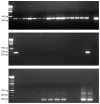Screening of Trypanosoma brucei gambiense in domestic livestock and tsetse flies from an insular endemic focus (Luba, Equatorial Guinea)
- PMID: 20544031
- PMCID: PMC2882337
- DOI: 10.1371/journal.pntd.0000704
Screening of Trypanosoma brucei gambiense in domestic livestock and tsetse flies from an insular endemic focus (Luba, Equatorial Guinea)
Abstract
Background: Sleeping sickness is spread over 36 Sub-Saharan African countries. In West and Central Africa, the disease is caused by Trypanosoma brucei gambiense, which produces a chronic clinical manifestation. The Luba focus (Bioko Island, Equatorial Guinea) has not reported autochthonous sleeping sickness cases since 1995, but given the complexity of the epidemiological cycle, the elimination of the parasite in the environment is difficult to categorically ensure.
Methodology/principal findings: The aim of this work is to assess, by a molecular approach (Polymerase Chain Reaction, PCR), the possible permanence of T. b. gambiense in the vector (Glossina spp.) and domestic fauna in order to improve our understanding of the epidemiological situation of the disease in an isolated focus considered to be under control. The results obtained show the absence of the parasite in peridomestic livestock but its presence, although at very low rate, in the vector. On the other hand, interesting entomological data highlight that an elevated concentration of tsetse flies was observed in two out of the ten villages considered to be in the focus.
Conclusions: These findings demonstrate that even in conditions of apparent control, a complete parasite clearance is difficult to achieve. Further investigations must be focused on animal reservoirs which could allow the parasites to persist without leading to human cases. In Luba, where domestic livestock are scarcer than other foci in mainland Equatorial Guinea, the epidemiological significance of wild fauna should be assessed to establish their role in the maintenance of the infection.
Conflict of interest statement
The authors have declared that no competing interests exist.
Figures


Similar articles
-
Trypanosoma brucei gambiense in domestic livestock of Kogo and Mbini foci (Equatorial Guinea).Trop Med Int Health. 2009 May;14(5):535-41. doi: 10.1111/j.1365-3156.2009.02271.x. Epub 2009 Mar 23. Trop Med Int Health. 2009. PMID: 19320872
-
Identification of different trypanosome species in the mid-guts of tsetse flies of the Malanga (Kimpese) sleeping sickness focus of the Democratic Republic of Congo.Parasit Vectors. 2012 Sep 19;5:201. doi: 10.1186/1756-3305-5-201. Parasit Vectors. 2012. PMID: 22992486 Free PMC article.
-
Evidence of the absence of human African trypanosomiasis in two northern districts of Uganda: Analyses of cattle, pigs and tsetse flies for the presence of Trypanosoma brucei gambiense.PLoS Negl Trop Dis. 2020 Apr 7;14(4):e0007737. doi: 10.1371/journal.pntd.0007737. eCollection 2020 Apr. PLoS Negl Trop Dis. 2020. PMID: 32255793 Free PMC article.
-
Challenges towards the elimination of Human African Trypanosomiasis in the sleeping sickness focus of Campo in southern Cameroon.Parasit Vectors. 2014 Aug 16;7:374. doi: 10.1186/1756-3305-7-374. Parasit Vectors. 2014. PMID: 25129168 Free PMC article. Review.
-
[Value of molecular biology in the identification of trypanosomes responsible for African trypanosomiasis or sleeping sickness].Med Trop (Mars). 2000;60(2):115-9. Med Trop (Mars). 2000. PMID: 11100432 Review. French. No abstract available.
Cited by
-
Challenges facing the elimination of sleeping sickness in west and central Africa: sustainable control of animal trypanosomiasis as an indispensable approach to achieve the goal.Parasit Vectors. 2015 Dec 16;8:640. doi: 10.1186/s13071-015-1254-y. Parasit Vectors. 2015. PMID: 26671582 Free PMC article.
-
Identifying transmission cycles at the human-animal interface: the role of animal reservoirs in maintaining gambiense human african trypanosomiasis.PLoS Comput Biol. 2013;9(1):e1002855. doi: 10.1371/journal.pcbi.1002855. Epub 2013 Jan 17. PLoS Comput Biol. 2013. PMID: 23341760 Free PMC article.
-
Deep kinetoplast genome analyses result in a novel molecular assay for detecting Trypanosoma brucei gambiense-specific minicircles.NAR Genom Bioinform. 2022 Oct 20;4(4):lqac081. doi: 10.1093/nargab/lqac081. eCollection 2022 Dec. NAR Genom Bioinform. 2022. PMID: 36285287 Free PMC article.
-
Epidemiology of human African trypanosomiasis.Clin Epidemiol. 2014 Aug 6;6:257-75. doi: 10.2147/CLEP.S39728. eCollection 2014. Clin Epidemiol. 2014. PMID: 25125985 Free PMC article. Review.
-
Molecular identification of Trypanosoma brucei gambiense in naturally infected pigs, dogs and small ruminants confirms domestic animals as potential reservoirs for sleeping sickness in Chad.Parasite. 2020;27:63. doi: 10.1051/parasite/2020061. Epub 2020 Nov 18. Parasite. 2020. PMID: 33206595 Free PMC article.
References
-
- Hoare CA. The trypanosomes of mammals. Oxford: Blackwell Scientific Publications; 1972. 749
-
- Gibson W. Resolution of the species problem in African trypanosomes. Int J Parasitol. 2007;37:829–38. - PubMed
-
- WHO. Human African Trypanosomiasis (sleeping sickness): epidemiological update. Weekly Epidemiological Record. 2006:69–80. - PubMed
-
- Simarro PP, Franco JR, Ndongo P, Nguema E, Louis FJ, et al. The elimination of Trypanosoma brucei gambiense sleeping sickness in the focus of Luba, Bioko Island, Equatorial Guinea. Trop Med Int Health. 2006;11:636–46. - PubMed
Publication types
MeSH terms
Substances
LinkOut - more resources
Full Text Sources
Medical
Miscellaneous

